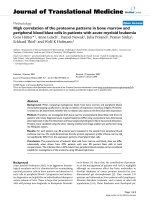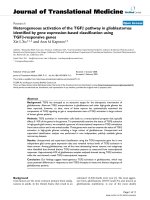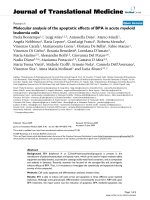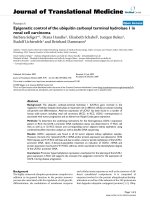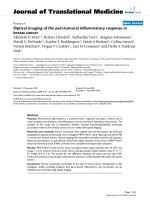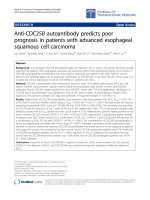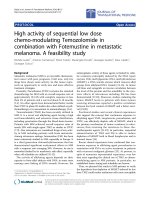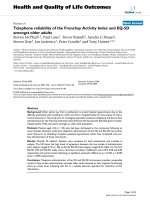báo cáo hóa học:" High correlation of the proteome patterns in bone marrow and peripheral blood blast cells in patients with acute myeloid leukemia" pot
Bạn đang xem bản rút gọn của tài liệu. Xem và tải ngay bản đầy đủ của tài liệu tại đây (409.92 KB, 8 trang )
BioMed Central
Page 1 of 8
(page number not for citation purposes)
Journal of Translational Medicine
Open Access
Methodology
High correlation of the proteome patterns in bone marrow and
peripheral blood blast cells in patients with acute myeloid leukemia
Gero Hütter*
1
, Anne Letsch
1
, Daniel Nowak
1
, Julia Poland
2
, Pranav Sinha
2
,
Eckhard Thiel
1
and Wolf-K Hofmann
1
Address:
1
Department of Internal Medicine III (Hematology, Onkology), Charité Berlin Campus Benjamin Franklin, Berlin, Germany and
2
Institute of Laboratory Medicine and Clinical Chemistry, LKH Klagenfurt, Austria
Email: Gero Hütter* - ; Anne Letsch - ; Daniel Nowak - ;
Julia Poland - ; Pranav Sinha - ; Eckhard Thiel - ; Wolf-
K Hofmann -
* Corresponding author
Abstract
Background: When comparing myelogenous blasts from bone marrow and peripheral blood,
immunophenotyping usually show a strong correlation of expression of surface antigens. However,
it remains to be determined, whether this correlation also exists on the level of protein expression.
Method: Therefore, we investigated both bone marrow and peripheral blood blast cells from six
patients with newly diagnosed acute myeloid leukemia (AML) using conventional two-dimensional
electrophoresis in the first dimension and linear polyacrylamide gels (12%) in the second dimension.
Proteins were visualized using the silver staining method and image analysis was performed using
the PDQuest system.
Results: For each patient over 80 proteins were evaluated in the sample from peripheral blood
and bone marrow. We could demonstrate that the protein expression profile of bone marrow did
not significantly differ from the expression patterns of peripheral blast cells.
Conclusion: The proteome-set of leukemic blast cells from marrow and blood, does not differ
substantially when drawn from AML patients with over 80 percent blast cells in both
compartments. This indicates that in AML, blasts from peripheral blood samples can be considered
suitable for investigations of the proteome using 2D-electrophoresis.
Background
Acute myeloid leukemia (AML) is an aggressive hemato-
logical neoplasia and it is characterized by accumulating
myeloid precursor cells in bone marrow and detection of
such cells in peripheral blood. Cytogenetics and molecu-
lar diagnostics are helpful for an individualized therapy in
certain subsets of AML. There is hope that proteomics in
AML will prompt new diagnostic or therapeutic biomark-
ers in future [1]. Up to date, the contribution of proteom-
ics to the management of patients with AML is negligible
although an enormous effort has been undertaken to
develop databases of cancer proteins detected by two-
dimensional gel electrophoresis [2]. They contain 2-D
patterns and information from patients with lymphopro-
liferative disorders, leukemia, and a variety of other cell
populations [3-6]. These databases were developed pri-
Published: 15 January 2009
Journal of Translational Medicine 2009, 7:7 doi:10.1186/1479-5876-7-7
Received: 12 September 2008
Accepted: 15 January 2009
This article is available from: />© 2009 Hütter et al; licensee BioMed Central Ltd.
This is an Open Access article distributed under the terms of the Creative Commons Attribution License ( />),
which permits unrestricted use, distribution, and reproduction in any medium, provided the original work is properly cited.
Journal of Translational Medicine 2009, 7:7 />Page 2 of 8
(page number not for citation purposes)
marily from in vitro cell cultures. Experiences with corre-
sponding in vivo samples are rare, even though cells from
hematological disorders can easily be obtained for protein
analysis. First investigations referring to the proteome of
leukemia in vivo were undertaken from Hanash in the
middle 80's. Hanash screened polypeptides as markers to
distinguish acute lymphoblastic leukemia (ALL) cell line-
ages [7]. Later the proteomic approach was used to iden-
tify Hsp27, which distinguishes between ALL in infants
and older children [8,9]. Recently, Balkhi and co-workers
were able to identify significant differences in the AML
proteome between cytogenetic groups of this disease.
They postulated, that analysis of the post-translational
modifications could be useful to distinguish different sub-
groups of AML [10].
Studies employing immunophenotyping methods in
acute myeloid leukemias (AML) have shown a strong cor-
relation of surface antigen expression comparing bone
marrow and peripheral blood blast cells [11]. However, it
remains unclear, whether there are differences in expres-
sion levels on either protein or RNA-level which may indi-
cate biological differences for both cell types.
In the present study, we aimed to investigate the profile of
protein expression of blast populations from peripheral
blood and bone marrow aspirates using a proteomic
approach with 2D-electrophoresis in newly diagnosed
patients with AML.
Materials and methods
Sample preparation and solubilization
Blast samples from bone marrow aspirates and peripheral
blood were isolated from six patients with Ficoll-centrifu-
gation and washed at least three times in large volumes of
phosphate-buffered saline (Table 1). The cell pellet was
solubilized according to Rabilloud in 9 M urea, 4% w/v
CHAPS, and 20 mM spermine and 40 mM DTT [12]. After
centrifugation to remove the precipitated nucleic acids,
the supernatant was collected, for protein determination
and for proteomic analysis.
Protein determination
Since high concentration of urea and detergents interfere
with any available protein assay system, we adapted a tur-
bidimetric assay especially for samples prepared for 2D
analysis[13]. In this assay, proteins are precipitated by
trichloroacetic acid and measured turbidimetrically at 720
nm. Briefly, 35 ml of each sample was pipetted in dupli-
cate in wells of a 96-well microtitre plates (Nunc, Den-
mark). One hundred ml of 0.1 M HCl was added to each
well and the mixture shaken for 1 mm. Twenty five ml of
20% TCA was added to each well. The optical density was
measured at 720 nm 5 min after TCA-addition using a
standard Dynatech MR 7000 ELISA photometer
(Dynatech, Hamburg). For evaluation, a non-linear stand-
ard curve with protein concentrations of 0.2, 1, 2 and 5
mg/ml was used. Control material from Boehringer Man-
nheim (Precinorm protein control serum) was used to
obtain the standard curves that were run with each deter-
mination.
First dimension isoelectric focusing (IEF)
First dimension glass tubes were placed in the Hoefer cast-
system. Solution for IEF contains 8.24 g urea, 1.95 ml acr-
ylamide solution (T = 28.38%, C = 1.92%)
1
, 600 μl car-
rier-ampholyte (CA) 5–7 (Servalyt), 200 μl CA 3.5–10
(Pharmacia), 3 ml Triton X 10%, 20 μl TEMED, and 30 μl
ammonium persulfate 10%. The cathodic chamber was
filled with 10 mM of sodium hydroxide and the anodic
chamber with 3.26 ml phosphoric acid 85%. The solution
for the overlay contained 20% glycerol and 2% CA. Focus-
ing started with 200 V for 15 minutes, followed by 300 V
for 30 minutes and finally with 400 V for 60 minutes.
After IE-focusing, the sample was added on the cathodic
side of the tube gel. The aliquot of the sample contained a
Table 1: Patient and sample characteristics.
Patient Sample-ID Age Gender FAB-subtype Karyotype Source WBC in
μ
L (% blasts)
A #02-05 60 Female M2 t(8;21) PB 4.8 (80%)
#02-02 BM *
B #02-06 22 Female M2 normal PB 379.0 (93%)
#02-03 BM *
C #02-24 63 Female M5b normal PB 120.0 (91%)
#02-25 BM *
D #02-33 46 Male M1 complex PB 11.2 (85%)
#02-34 BM *
E #02-37 27 Female M0 t(9;11) PB 5.2 (81%)
#02-36 BM *
F #02-39 58 Male M4 normal PB 37.0 (87%)
#02-38 BM *
WBC = white blood cell count, * = bone marrow samples were adjusted to 1.000.000 mononuclear cells per assay.
Journal of Translational Medicine 2009, 7:7 />Page 3 of 8
(page number not for citation purposes)
total of 10 μg of protein. Electrophoresis started with 200
V for 15 minutes, followed by 300 V for 30 minutes and
finally 400 V for 12 hours.
Second dimension SDS-page
Tube-gels were sealed on top of linear polyacrylamide gels
(T = 30%, C = 2%) using a sealing solution (1% agarose,
0.2% SDS, 0.15 M Bis/Tris, 0.1 M HCl). The Iso-Dalt Sys-
tem contained a buffer of 58 g tris base, 299 g glycine, and
100 ml SDS 20%. The run was completed at 20 mA/gel
until the tracking dye reached the bottom of the gel [14].
After electrophoresis, the gels were fixed in 50% ethanol,
and 10% acetic acid for 12 hours.
Silver staining
Proteins were visualized using the silver staining method
employing a modification of the method of Heukeshoven
according to Sinha et al. [15,16].
Image Analysis and Spot Identification
Image analysis was performed using the PDQuest system
according to the protocols provided by the manufacturer
after scanning with the densitometer GS-710 (Bio-Rad,
CA, USA), the spot pattern of each patient sample was
summarized in a gel image. For protein identification,
each gel image was matched to the previously 130 identi-
fied spots of the gastric carcinoma cell line EPG85-257
[17]. To yield information about changes in the protein
expression gel images of peripheral and blood sample for
each patient were matched. The following criteria for dif-
ferential protein expression were used: (i) spot intensity:
four-fold increased = differential overexpression; (ii) spot
intensity: four-fold decreased = differential under-expres-
sion.
Results
Matching of samples
In the pH range 4.0–8.0, conventional 2-D electrophore-
sis of the 12 samples yielded about 700–900 spots, respec-
tively (Figure 1). We were able to identify a maximum of
107 proteins in the AML samples. 23 Spots of the gastric
cancer cell line were not represented in the AML samples.
Intra-individual analysis of the spot patterns showed a
high correlation between the sample from peripheral
blood and bone marrow (Table 2). On/off-phenomena of
the identified spots were observed in four cases: Spot No.
19 (annexin 6) was found in patient A in the sample of
peripheral blood but not in bone marrow, in patient B an
inverse constellation was detected concerning this protein
(Figure 2). As a third variance an absence of spot No. 102
(phosphoglyceromutase) was only found in the bone
marrow of patient B. The fourth change concerned spot
No. 130 (vimentin) which was only represented in the
peripheral blood sample of patient B.
In addition, for the patients A, B and E with refractory
leukemia, there were additional samples available from
the time of relapse. The intervals for the date of collection
from the first sample were: 6 months for patient A, 14
days for patient B, and 3 days for patient E. Analysis of the
spot patterns from these samples showed an identical pro-
file as compared to the previously collected samples of the
same individual (data not shown).
Six proteins with two additional variants were found to be
expressed differentially within bone marrow and periph-
eral blood cells of selected individuals (Table 2). Spot No.
5 (14-3-3 related) was only present in patient C, spot No.
121 and 122 (TCHTP and variant) was only present in
patient F and G, respectively. Spot 60 (FK506 binding pro-
tein 4) was absent in patient D and spots No. 91 (Ku anti-
gen) and 115 (Rho A) were not present in patient C
(Figure 3). Furthermore, only patients F and G showed an
expression of plasminogenactivator inhibitor-2 and a var-
iant (spots 103 and 104).
Discussion
Analysis of cell populations in vivo can provide the highest
degree of fidelity for a snapshot of the protein changes
that occur as a cause or consequence of the malignancy.
Proteins rather than genes or mRNAs represent the key
players in the cell. Expression levels of proteins determine
the cellular phenotype and its plasticity in response to
external signals. The aim of this study was to investigate
the protein expression profiles of myelogenous blasts
from patients with AML collected from two compart-
ments, bone marrow and peripheral blood.
We previously used a cell culture model derived from ther-
moresistant gastric cancer to build up a database for 2D-
electrophoresis patterns [17]. After matching the gel
images of the AML samples with the images of the gastric
cancer cell line, we found some differences in the protein
patterns but overall, these changes were small: Seven pro-
teins (with two variants) were clearly defined in the gastric
carcinoma cell line but not in the AML samples (Spots-
No. 4, 64, 103, 108, 114, 121, 123) (Table 3). The major-
ity of these proteins have unspecific or unknown func-
tions or they are clearly related to tissues and not to
hematological cells [18-23].
As an example, protein spot No. 4 (14-3-3σ) is a family
member of proteins that regulate cellular activity by bind-
ing and sequestering phosphorylated proteins. 14-3-3σ
promotes pre-mitotic cell-cycle arrest following DNA
damage, and its expression can be controlled by the p53
tumor-suppressor gene [24]. None of the investigated
AML-samples exhibited a 14-3-3σ expression in the 2D
pattern. Analysis of other AML samples which did not
meet the inclusion criteria for this investigation showed
Journal of Translational Medicine 2009, 7:7 />Page 4 of 8
(page number not for citation purposes)
2-D pattern of the silver stained gel image of the master gel imageFigure 1
2-D pattern of the silver stained gel image of the master gel image. 2-D pattern of the silver stained gel image of a
master gel image containing the spot information of all investigated samples. For protein identification, each gel image was
matched to the previously 130 identified spots of the gastric carcinoma cell line EPG85-257. Proteins identified to date are
marked with arrows and numbered according to Sinha et al. [17].
29
130
100
89
70
60
52
43
36
38
33
25
30
20
16
10
4.1 4.5
4.9
5.1 5.5 7.4 7.85.9 6.3 6.9pI
Mr
Journal of Translational Medicine 2009, 7:7 />Page 5 of 8
(page number not for citation purposes)
Table 2: Different protein expression in AML.
Patient/Sample-
No.
ABCDE F
Spot-
No.
Protein #02-
05p
#02-
02b
#02-
06p
#02-
03b
#02-
24p
#02-
25b
#02-
33p
#02-
34b
#02-
37p
#02-
36b
#02-
39p
#02-
38b
5 14-3-3 related + +
19 Annexin 6,
Calectrin
(67 kDa)
+ ++++ +++++
60 FK506 binding
protein 4
++++++ ++++
91 Ku antigen
(86 kDa)
++++ + +++++
102 Phosphoglycero
mutase
++ ++++ +++++
103 Plasminogen
activator
inhibitor-2
++++
104 Plasminogen
activa. inhib 2
var.
++++
115 Rho A * * + + + + + + + +
121 TCHTP * * + +
122 TCHTP var. * * + +
130Vimentin ++ ++++ +++++
Detail of the two-dimensional patterns of patient AFigure 2
Detail of the two-dimensional patterns of patient A. Detail of the two-dimensional patterns of patient A. Different
expression of spot 19 (annexin 6) in the bone marrow sample in comparison to peripheral blood.
#02-05p #02-02b
Annexin 6
76
76
77
77
129
129
67 67
Patient A
Journal of Translational Medicine 2009, 7:7 />Page 6 of 8
(page number not for citation purposes)
similar results: the expression of 14-3-3σ in AML blast is
an infrequent event. This observation corresponds to
investigations in breast cancer and small cell lung carci-
noma. In breast cancer a hypermethylation of the CpG
island of the σ gene was found that leads to gene silencing
and absence of 14-3-3σ. The authors conclude, that the
loss of σ expression contributes to malignant transforma-
tion by impairing the G
2
cell cycle checkpoint function,
thus allowing an accumulation of genetic defects [25,26].
Interestingly, there were only marginal differences in the
expression profiles comparing patient to patient. This was
also observed in studies with patients with B-cell chronic
lymphocytic leukemia (CLL). In CLL, analysis allowed the
identification of proteins that clearly discriminated
between the patients groups with defined chromosomal
characteristics or clinical parameters such as patient sur-
vival [27].
Expression of the plasminogen activator inhibitor-2 (PAI-
2) was only found in patients E and F with the subtyp FAB
M0 and M4, respectively. This finding is inline with data
from the PAI-2 serum levels of patients with hematologi-
cal malignancies, where different expression levels were
correlated with different serum levels for PAI-2 in the AML
subtypes FAB M4 and M0 [28]. As an explanation it was
postulated, that myeloid blasts, like their non-tumoral
counterparts, monocytes/macrophages, are able to syn-
Detail of the two-dimensional patterns with different expression of the Ku antigenFigure 3
Detail of the two-dimensional patterns with different expression of the Ku antigen. Selective deficiency of spot 91
(Ku antigene, marked with an arrow) in patient C whereas expression is detectable in other patients irrespectively of sample
origin.
#02-02b
#02-36b
#02-38b
#02-03b
#02-24b
#02-05p
#02-06p
#02-25p
#02-39p
#02-37p
Journal of Translational Medicine 2009, 7:7 />Page 7 of 8
(page number not for citation purposes)
thesize most components of the plasminogen activation
system. Among the numerous features shared by normal
monocytes and M4 cells were the capability to migrate to
areas of inflammation and to infiltrate extramedullary tis-
sues like gingival enlargement [29].
Furthermore, we have observed that the protein patterns
from samples from bone marrow and peripheral blood
from the same patient show a high correlation. The
observed changes are marginal and inter-individually var-
iable.
Conclusion
In conclusion, the protein expression profile in AML
blasts collected from bone marrow aspirates in compari-
son to blasts from peripheral blood samples do not differ
basically. This may indicate, that samples of peripheral
blood with high amounts of blasts are to be considered
suitable for investigations of the proteome using 2D-elec-
trophoresis. Furthermore, protein expression profiling is
likely to further impact the analysis of mechanisms
involved in acute leukemia by examining routinely avail-
able biological material.
Competing interests
The authors declare that they have no competing interests.
Authors' contributions
GH, AL, DN, and JP carried out the 2D electrophoresis
and all other experimental work. PS, ET, and WKH coor-
dinated the laboratory work and helped to draft the man-
uscript. All authors read and approved the final
manuscript.
Note
1
%T = [(acrylamide + bis-acrylamide) × 100]/total weight
%C = (bis-acrylamide × 100)/(bis-alcrylamide + acryla-
mide)
Acknowledgements
This work was supported by a grant from the Deutsche José Carreras
Leukämie Stiftung, Munich, Germany (SP 03/06).
References
1. Sjoholt G, Anensen N, Wergeland L, Mc Cormack E, Bruserud O,
Gjertsen BT: Proteomics in acute myelogenous leukaemia
(AML): methodological strategies and identification of pro-
tein targets for novel antileukaemic therapy. Curr Drug Targets
2005, 6(6):631-646.
2. Czibere A, Grall F, Aivado M: Perspectives of proteomics in
acute myeloid leukemia. Expert Rev Anticancer Ther 2006,
6(11):1663-1675.
3. Hanash SM, Teichroew D: Mining the human proteome: experi-
ence with the human lymphoid protein database. Electrophore-
sis 1998, 19(11):2004-2009.
4. Hanash SM, Madoz-Gurpide J, Misek DE: Identification of novel
targets for cancer therapy using expression proteomics.
Leukemia 2002, 16(4):478-485.
5. Lefkovits I, Kettman JR, Coleclough C: A strategy for founding a
global lymphocyte proteinpaedia and gene catalogue. Immu-
nol Today 1990, 11(5):157-162.
6. Kettman JR, Coleclough C, Lefkovits I: Lymphocyte Proteinpae-
dia stage two: T-cell polypeptides from a partitioned cDNA
library revealed by the dual decay method. Int Arch Allergy
Immunol 1994, 103(2):131-142.
7. Hanash SM, Baier LJ, McCurry L, Schwartz SA: Lineage-related
polypeptide markers in acute lymphoblastic leukemia
detected by two-dimensional gel electrophoresis. Proc Natl
Acad Sci USA 1986, 83(3):807-811.
8. Hanash SM, Kuick R, Strahler J, Richardson B, Reaman G, Stoolman L,
Hanson C, Nichols D, Tueche HJ: Identification of a cellular
polypeptide that distinguishes between acute lymphoblastic
leukemia in infants and in older children. Blood 1989,
73(2):527-532.
9. Strahler JR, Kuick R, Hanash SM: Diminished phosphorylation of
a heat shock protein (HSP 27) in infant acute lymphoblastic
leukemia. Biochem Biophys Res Commun 1991, 175(1):134-142.
10. Balkhi MY, Trivedi AK, Geletu M, Christopeit M, Bohlander SK, Behre
HM, Behre G: Proteomics of acute myeloid leukaemia:
Cytogenetic risk groups differ specifically in their proteome,
interactome and post-translational protein modifications.
Oncogene 2006, 25(53):7041-7058.
11. Griffin JD, Davis R, Nelson DA, Davey FR, Mayer RJ, Schiffer C, McIn-
tyre OR, Bloomfield CD: Use of surface marker analysis to pre-
dict outcome of adult acute myeloblastic leukemia. Blood
1986, 68(6):1232-1241.
12. Rabilloud T: Use of thiourea to increase the solubility of mem-
brane proteins in two-dimensional electrophoresis. Electro-
phoresis 1998, 19(5):758-760.
13. Cheung CK, Mak YT, Swaminathan R: Automated trichloroacetic
acid precipitation method for urine total protein. Ann Clin Bio-
chem 1987, 24(Pt 2):140-144.
Table 3: Proteins as expressed in the gastric cell line but not in AML.
No. Protein name General function Ref.
414-3-3σ Adapter protein for phosphoserin motifs. Regulated the interactions and subcellular
localization of signalling molecules.
[18]
64 γ-Catenin Forms a complex with α- and β-Catenin to Cadherins, that are involved in the formation
and maintenance of the histo-architecture.
[19]
103 Plasmonogen activator inhibitor-2 (PAI-2) Involved in the regulation and inhibition of binding between urokinase-type plasminogen
activator and its receptor, involved in physiological and pathological proteolysis and
extracellular matrix degradation.
[20]
108 Proteasome δ Cleavage at peptide bonds with very broad specificity [21]
114 Reticulocalbin (RCN) RCN is a member of the EF-hand Ca(2+)-binding protein family and may regulate calcium-
dependent activities in the endoplasmatic reticulum lumen or post-ER compartment
[22]
121 TCHTP Cytoplasmatic Ca2(+)-binding protein [23]
123 Transgelin 2 Unknown
Publish with Bio Med Central and every
scientist can read your work free of charge
"BioMed Central will be the most significant development for
disseminating the results of biomedical research in our lifetime."
Sir Paul Nurse, Cancer Research UK
Your research papers will be:
available free of charge to the entire biomedical community
peer reviewed and published immediately upon acceptance
cited in PubMed and archived on PubMed Central
yours — you keep the copyright
Submit your manuscript here:
/>BioMedcentral
Journal of Translational Medicine 2009, 7:7 />Page 8 of 8
(page number not for citation purposes)
14. Celis JE, Gesser B, Dejgaard K, Honore B, Leffers H, Madsen P,
Andersen A, Basse B, Celis A, Lauridsen JB, et al.: Two dimensional
gel human protein databases offer a systematic approach to
the study of cell proliferation and differentiation. Int J Dev Biol
1989, 33(4):407-416.
15. Klose J, Kobalz U: Two-dimensional electrophoresis of pro-
teins: an updated protocol and implications for a functional
analysis of the genome. Electrophoresis 1995, 16(6):1034-1059.
16. Sinha P, Poland J, Schnolzer M, Rabilloud T: A new silver staining
apparatus and procedure for matrix-assisted laser desorp-
tion/ionization-time of flight analysis of proteins after two-
dimensional electrophoresis. Proteomics 2001, 1(7):835-840.
17. Sinha P, Poland J, Schnolzer M, Celis JE, Lage H: Characterization
of the differential protein expression associated with ther-
moresistance in human gastric carcinoma cell lines. Electro-
phoresis 2001, 22(14):2990-3000.
18. Ferl RJ, Manak MS, Reyes MF: The 14-3-3s. Genome Biol 2002, 3(7):.
19. Ozawa M: Identification of the region of alpha-catenin that
plays an essential role in cadherin-mediated cell adhesion. J
Biol Chem 1998, 273(45):29524-29529.
20. Andreasen PA, Egelund R, Petersen HH: The plasminogen activa-
tion system in tumor growth, invasion, and metastasis. Cell
Mol Life Sci 2000, 57(1):25-40.
21. Ding Q, Reinacker K, Dimayuga E, Nukala V, Drake J, Butterfield DA,
Dunn JC, Martin S, Bruce-Keller AJ, Keller JN: Role of the protea-
some in protein oxidation and neural viability following low-
level oxidative stress. FEBS Lett 2003, 546(2–3):228-332.
22. Ozawa M, Muramatsu T: Reticulocalbin, a novel endoplasmic
reticulum resident Ca(2+)-binding protein with multiple EF-
hand motifs and a carboxyl-terminal HDEL sequence. J Biol
Chem 1993, 268(1):699-705.
23. Reymond MA, Sanchez JC, Hughes GJ, Gunther K, Riese J, Tortola S,
Peinado MA, Kirchner T, Hohenberger W, Hochstrasser DF, et al.:
Standardized characterization of gene expression in human
colorectal epithelium by two-dimensional electrophoresis.
Electrophoresis 1997, 18(15):2842-2848.
24. Chan TA, Hermeking H, Lengauer C, Kinzler KW, Vogelstein B: 14-
3-3Sigma is required to prevent mitotic catastrophe after
DNA damage. Nature 1999, 401(6753):616-620.
25. Osada H, Tatematsu Y, Yatabe Y, Nakagawa T, Konishi H, Harano T,
Tezel E, Takada M, Takahashi T: Frequent and histological type-
specific inactivation of 14-3-3sigma in human lung cancers.
Oncogene 2002, 21(15):2418-2424.
26. Ferguson AT, Evron E, Umbricht CB, Pandita TK, Chan TA, Herme-
king H, Marks JR, Lambers AR, Futreal PA, Stampfer MR, et al.: High
frequency of hypermethylation at the 14-3-3 sigma locus
leads to gene silencing in breast cancer. Proc Natl Acad Sci USA
2000, 97(11):6049-6054.
27. Voss T, Ahorn H, Haberl P, Dohner H, Wilgenbus K: Correlation
of clinical data with proteomics profiles in 24 patients with B-
cell chronic lymphocytic leukemia. Int J Cancer 2001,
91(2):180-186.
28. Scherrer A, Kruithof EK, Grob JP: Plasminogen activator inhibi-
tor-2 in patients with monocytic leukemia. Leukemia 1991,
5(6):479-486.
29. Scherrer A, Wohlwend A, Kruithof EK, Vassalli JD, Sappino AP: Plas-
minogen activation in human acute leukaemias. Br J Haematol
1999, 105(4):920-927.
